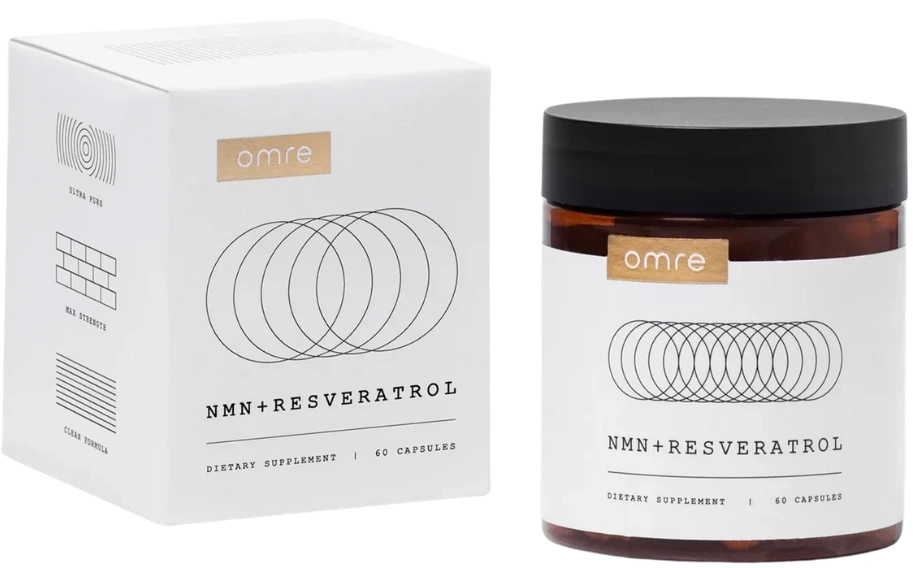Table of Contents
NAD IV therapy can cause side effects like nausea, headaches, dizziness, and muscle cramps, especially if the infusion is given too quickly or without proper care.
This treatment has become popular for people looking to increase energy, focus, and slow down signs of aging. But while some users report benefits, there are also side effects and safety concerns that often get overlooked.
In this article, we’ll explain exactly what NAD IV therapy is, break down the most common side effects, and help you decide if it’s right for you.
Cellular NAD+ booster with ultra‑pure NMN and Resveratrol, at research‑backed doses.*NMN + RESVERATROL
Key Takeaways
NAD IV therapy can cause side effects like nausea, headaches, flushing, dizziness, and fatigue, especially when the infusion is too fast or not properly monitored.
Less common risks include allergic reactions, brain fog, muscle cramps, and digestive issues, particularly in people with underlying health conditions.
Long-term safety is unclear, and research on NAD IV therapy is still limited, making oral NAD+ precursors like NMN and NR a safer alternative.
Choosing a licensed provider and going slow with the drip can help reduce side effects, but many people may benefit more from high-quality NAD+ supplements instead.
What Is NAD IV Therapy?
NAD IV therapy is a treatment where nicotinamide adenine dinucleotide (NAD+) is delivered directly into your bloodstream through an IV drip.
NAD+ is a natural molecule found in every cell of your body. It plays a big role in how your cells make energy, repair DNA, and stay healthy. As we age, NAD+ levels go down, which may lead to tiredness, slower recovery, and signs of aging.
The idea behind NAD IV therapy is that by giving NAD+ directly through a vein, your body can absorb it more quickly than if you took it by mouth. Many clinics offer it to people who want to feel more energized, mentally sharp, or youthful.
However, the science around how well this treatment actually works is still limited. And like any IV therapy, it comes with some risks and side effects you should know about before trying it.
Common Side Effects of NAD IV Therapy
 Most people tolerate NAD IV therapy well, but some may experience side effects during or after the treatment. These are often mild, but they can be uncomfortable, especially if the drip is too fast or the dose is too high.
Most people tolerate NAD IV therapy well, but some may experience side effects during or after the treatment. These are often mild, but they can be uncomfortable, especially if the drip is too fast or the dose is too high.
Nausea and Stomach Discomfort
Many people report feeling queasy during or right after their NAD IV session. This can happen because NAD+ may stimulate certain enzymes and gut activity that upset the stomach.
Slowing down the infusion rate or drinking plenty of water before treatment often helps reduce this issue.
Headaches
Headaches are another common side effect. They can range from mild to moderate and may come on during or shortly after the session.
This might be due to how NAD+ affects blood vessels and brain chemistry. Staying hydrated and doing the infusion slowly can help prevent it.
Fatigue or Weakness
It might sound odd, but some people feel drained after their NAD IV treatment. This can happen as the body adjusts to a sudden increase in NAD+ levels.
The tiredness usually fades within a day or two, but it can catch you off guard, especially if you expected an energy boost right away.
Dizziness or Lightheadedness
Some users feel dizzy or faint, especially during the first half of the infusion. This could be related to changes in blood pressure or the body’s reaction to the infusion speed.
Lying down and relaxing during the session can help ease this feeling.
Flushing or Warm Sensation
A warm or flushed feeling in the face, chest, or body is fairly common. This happens because NAD+ can cause blood vessels to widen slightly, increasing blood flow.
While it’s usually harmless, it can feel strange if you’re not expecting it.
Muscle Cramps or Tension
Occasionally, people experience tightness or cramping in their muscles, most often in the neck, back, or arms.
This may be linked to how NAD+ affects nerve signaling or electrolyte balance. If this happens, let the provider know so they can adjust the drip speed or stop the session if needed.
NMN + RESVERATROL
Cellular NAD+ booster with ultra‑pure NMN and Resveratrol, at research‑backed doses.*
Less Common but Concerning Risks
-v1749248631801.webp) While most side effects of NAD IV therapy are mild, a few less common ones can be more serious. These don’t happen often, but they’re important to know, especially if you have allergies or medical conditions.
While most side effects of NAD IV therapy are mild, a few less common ones can be more serious. These don’t happen often, but they’re important to know, especially if you have allergies or medical conditions.
Allergic Reactions
Although rare, some people may be allergic to ingredients in the IV solution, especially preservatives or stabilizers. Signs of an allergic reaction include itching, hives, swelling, or trouble breathing.
This is why it’s important to share any known allergies with your provider before the treatment begins.
Injection Site Reactions
Because the therapy involves an IV drip, you may experience redness, swelling, or tenderness at the spot where the needle was inserted.
In some cases, the area may bruise or feel sore for a day or two. If the needle isn’t placed properly, it can also cause a lump or vein inflammation, known as phlebitis.
Brain Fog or Cognitive Slowness
Some people report feeling mentally cloudy after treatment. This may be due to shifts in neurotransmitter activity or how fast NAD+ is introduced into the body.
If it happens, the best approach is to rest, drink water, and speak with your provider about slowing the drip rate in future sessions.
Diarrhea or Abdominal Pain
Digestive issues like cramps or loose stools can occur, especially if your body isn’t used to high doses of NAD+. These effects are usually temporary, but they can be unpleasant.
Drinking fluids and eating a light meal before the session might help reduce the risk.
Who Should Avoid NAD IV Therapy?
This therapy is not for everyone. If you have certain health conditions or are in a sensitive stage of life, it's best to avoid NAD IV treatment or talk to a doctor first.
People with known allergies to IV ingredients or preservatives
Pregnant or breastfeeding women
Children and teens
Adults over 65 with chronic illnesses
Individuals with blood pressure problems or heart conditions
Anyone taking medications that could interact with NAD+
How to Minimize NAD IV Side Effects
If you're planning to try NAD IV therapy, a few small steps can help lower your chances of side effects and make the experience smoother.
Stay well hydrated before and after your session: Drinking water before your treatment helps your veins stay open and reduces the risk of headaches, dizziness, or nausea. Keep sipping water after the session too, since NAD+ can affect your body’s fluid balance.
Ask your provider to go slow with the drip: A slower drip rate allows your body to adjust to the infusion better. This can help prevent common issues like flushing, nausea, and cramps. Don’t hesitate to ask for a longer session if it means feeling more comfortable.
Make sure you're in a calm, seated or lying position: Sitting or lying down during the treatment helps your body relax and lowers the risk of feeling lightheaded or dizzy. It also makes it easier for the provider to monitor how you're doing.
Eat a light snack beforehand unless fasting is required: Having a small meal or snack can help settle your stomach and keep your blood sugar steady. If your provider says fasting isn’t needed, avoid going in on an empty stomach.
Share your full medical history and medication list: Always tell your provider about any health conditions or medications you're taking. Some drugs may interact with NAD+, and your health history can affect how your body reacts to the therapy.
Choose a licensed provider with experience in IV therapy: Not all providers are the same. Make sure you’re getting treated by someone qualified and trained in administering IV drips. This lowers the risk of improper needle placement or infection.
Watch for side effects and speak up if anything feels off: If you feel strange at any point—whether it’s a headache, chest tightness, or brain fog—let your provider know right away. Early signs can often be managed quickly by adjusting the drip or stopping the session.
Long-Term Safety: What Science Says So Far
At this point, there’s not enough solid research to say whether long-term NAD IV therapy is truly safe or not. Most studies focus on short-term effects, often in small groups or very specific health settings.
For example, one study from 2019 looked at NAD+ infusions for addiction recovery and noted improvements in symptoms, but it didn’t track long-term outcomes or general health risks (1).
Another concern is that NAD+ is a large molecule. Some researchers question whether it can even be absorbed effectively through IV without being broken down first (2).
Unlike smaller precursors like NMN or NR, NAD+ may not make it into cells as efficiently as people expect. This raises questions about both safety and effectiveness.
There’s also the issue of quality. Since NAD IV therapy is not FDA-approved for treating any condition, the products used can vary in strength and purity from one clinic to another. Additives or preservatives in the IV solution may trigger reactions in sensitive individuals.
In short, while NAD+ IV therapy is often marketed as a cutting-edge anti-aging or energy solution, the long-term science just isn’t there yet.
Anyone considering regular infusions should approach with caution and always speak with a trusted healthcare provider.
Is There a Safer Alternative?
Yes. Instead of using NAD+ directly through IVs, many experts recommend NAD+ precursors like NMN (Nicotinamide Mononucleotide) and NR (Nicotinamide Riboside). These are smaller molecules that your body naturally converts into NAD+ inside the cells.
Clinical studies have shown that NMN and NR are better absorbed when taken orally and come with fewer side effects. They also don’t require needles or clinic visits, making them a more convenient option for most people.
Here’s why NMN and NR might be a better fit:
Backed by human and animal studies for boosting NAD+ levels
Linked to better energy, metabolism, and brain function
Easier to take daily as a capsule or powder
Lower risk of side effects like nausea or vein irritation
More affordable and accessible than IV therapy
 If you’re looking for a safer, research-supported way to support cellular health, check the availability of Omre NMN + Resveratrol.
If you’re looking for a safer, research-supported way to support cellular health, check the availability of Omre NMN + Resveratrol.
Final Words
NAD IV therapy may sound appealing, especially with promises of more energy, better focus, or slower aging. But it’s important to look past the hype.
While some people feel benefits, side effects like nausea, fatigue, or dizziness are not uncommon. And the long-term safety is still a big question mark.
If you're exploring ways to support your health, NAD+ precursors like NMN and NR offer a smarter, science-backed option. They’re easier on your body, better absorbed, and come with fewer risks.
Always talk to a healthcare provider before starting any new supplement or therapy. Your safety and well-being should come first, no matter what the trend.
FAQs
Can NAD IV therapy cause allergic reactions?
Yes, although rare, allergic reactions can happen, usually due to additives or preservatives in the IV solution rather than NAD+ itself. If you have known allergies, make sure to tell your provider before treatment.
What should I do if I feel sick after NAD IV therapy?
Mild symptoms like nausea or fatigue usually go away on their own. If you feel unwell, rest, drink fluids, and let your provider know. If symptoms are severe or don’t improve, seek medical attention.
Is NAD IV therapy approved by the FDA?
No, NAD IV therapy is not FDA-approved to treat any condition. It’s considered experimental and is not regulated the same way as prescription treatments.
How often can you safely get NAD IV therapy?
Some clinics recommend weekly or monthly sessions, but there’s no official guideline. The right schedule depends on your health, goals, and how your body reacts. Talk to a healthcare provider for advice that fits your situation.
Does NAD IV therapy work better than NMN supplements?
Not necessarily. NMN supplements are backed by more clinical studies and are easier for the body to absorb over time. For many people, they’re a safer and more practical choice than IV therapy.





